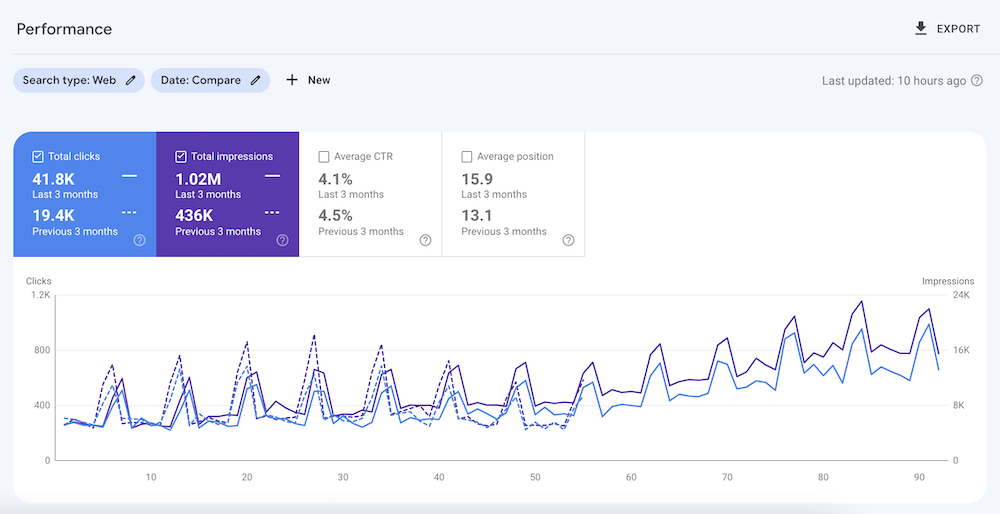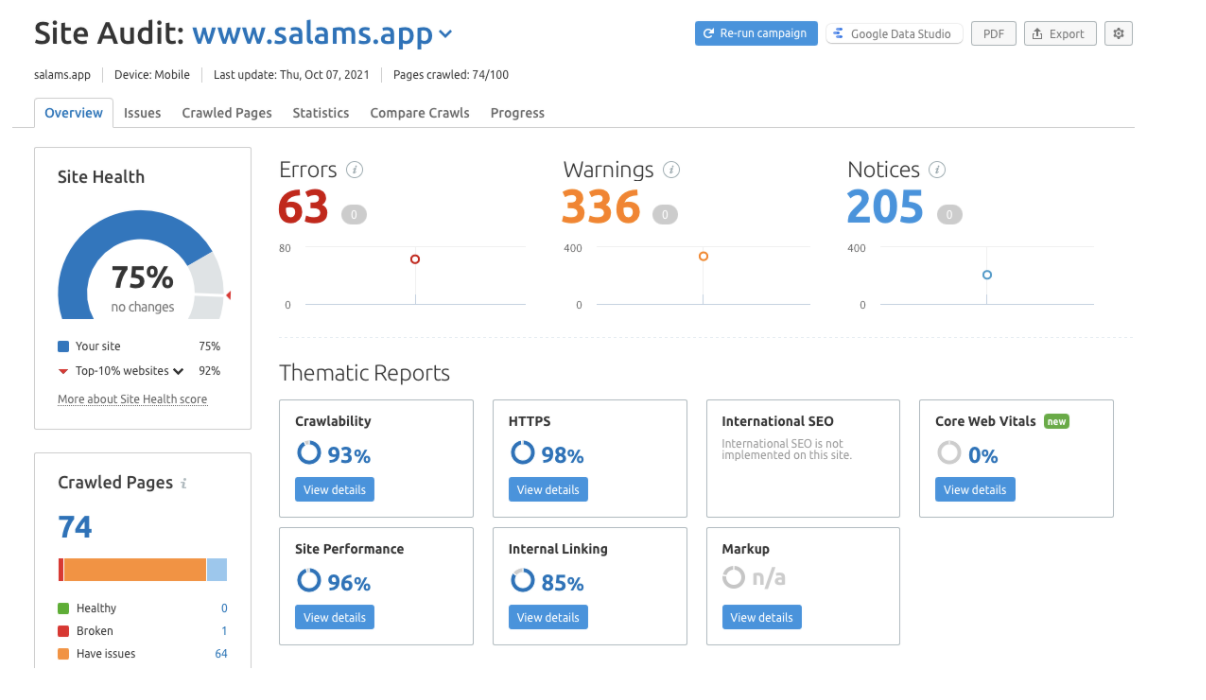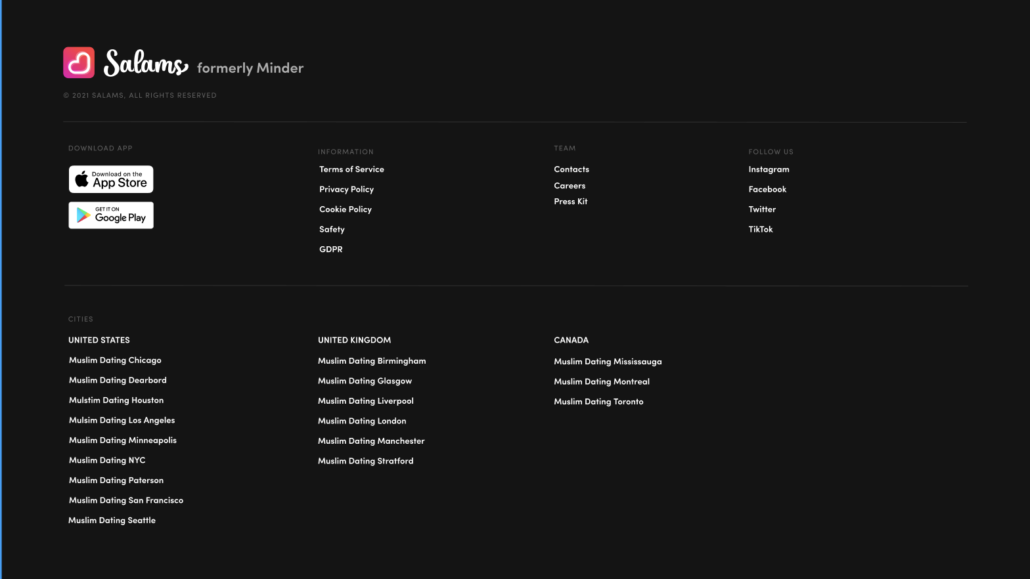How to Increase Your Organic Traffic by 117% in 90 Days: The Inside Story of Salam’s SEO Strategy
When it comes to driving traffic and revenue from organic search, it’s typically a long-term solution and not a quick fix. Organic traffic, in general, is high-quality, intent-driven with higher conversion rates than direct or paid, making it incredibly valuable to almost any acquisition strategy. It’s why, even though it can take longer than a Facebook campaign or YouTube ad, as a growth marketing agency, we almost always recommend it as a core growth tactic.
In October of 2021, Salams reached out to Tuff, asking our team to run a quick SEO audit and see what the organic growth potential was like for their market. Salams is an online dating app for Muslims that dominates the US market and is growing in the UK and other countries. Their growth, to date, has primarily relied on mobile install campaigns, meaning their website had very little content and their SEO strategy had never been a focal point for growth.
After working on an organic acquisition strategy with Salams in November and then implementing SEO tactics in December and January, the results were staggering and immediate. Here’s the data from the last three months compared to the previous three months:
- Impressions are up 130%
- Organic traffic is up 117%
And when it comes to keyword movement, here’s what we are looking at today:
- From #12 to #1 for Muslim dating (Our #1 target keyword)
- NEW: Ranking #2 for Muslim man
- From #68 to #1 for Muslim dating rules
- NEW: Ranking #2 for walima
- NEW: Ranking #1 for dating a Muslim girl
- NEW: Ranking #1 for dating a Muslim man
- From #20 to #4 for Muslim dating site
- From #35 to #1 for dating a Muslim
- NEW: Ranking #1 for Islam dating rules
- NEW: Ranking #1 for dating a Muslim guy
- NEW: Ranking #3 for what is Nikah
In this blog post, we’re going to outline the steps we took to get these results and explain how you can replicate this strategy. While your results will vary depending on the competition, search volume, your existing traction, and the search landscape, there are elements of this process that can be applied to drive organic traffic and revenue for almost any business.
- Start with foundational research and let this inform your strategy
- Fix any and all technical SEO issues
- Identify your list of focus keywords in a spreadsheet
- Leverage on-page SEO to optimize all current pages for target keywords
- Use your focus keywords to build an SEO content plan that includes blog posts, landing pages, programmatic efforts, and onsite remediation
- Publish new content that maps back to your focus keywords
- Ensure all SEO updates are amplified with strong UX
Foundational Research
First things first, you have to know where you are starting from and what the search landscape is for your market. This will help you set realistic organic growth projections, as well as outline the right strategy to get there.
For Salams, we wanted to answer two questions with our foundational research:
- Are people searching for a Muslim dating app?
- If so, how do we make sure Salams shows up when they are searching so we can capture that demand and grow our organic traffic and revenue?
In order to understand the answer to the above, we conducted initial foundational research in three ways:
- We ran a technical SEO audit using SEMRush (What’s the foundation like now?)
- We audited the primary search competitors (Who is the big player and can we compete?)
- We reviewed Salam’s existing rankings and current performance (Where are we starting from and how far do we need to go?)
The combination of the information and data above, helped us identify where the biggest opportunities were, how competitive the space was going to be, and what realistic organic traffic and revenue predictions could look like for Salams. If you’re going to invest time and resources into something, you want to know how it might impact your growth so you can prioritize it accordingly.
Technical SEO Fixes
When we ran our SEO audit, the Salams site had the issues and warnings found below, with an overall site health ranking of 75%.
Errors
- 52 issues with duplicate title tags
- 8 pages had duplicate content issues
- 2 pages had duplicate meta descriptions
- 1 pages returned a 4XX status code
Warnings
- 63 pages had no hreflang and lang attributes
- 63 issues with unminified JavaScript and CSS files
- 59 pages didn’t have meta descriptions
- 56 pages didn’t have enough text within the title tags
- 53 external links were broken
- 17 pages had low text-HTML ratio
- 15 pages had a low word count
- 5 links on HTTPS pages led to HTTP page
- 5 pages didn’t have an h1 heading
Technical SEO is often the “tiebreaker” for sites aiming for Google’s first page so the first thing we did in October was fix as many of these 63 errors as possible. Implementing technical SEO basics is essential if you want to ensure that your web pages are structured for both humans and crawlers – and is something you need to fix before producing more content.
Focus Keyword List
Once the technical SEO audit was done and the issues were fixed (site health increased to 96%), we built a focus keyword list – these were terms we wanted to rank for because they were relevant to Salams and would bring us more quality organic traffic. For Salams, we identified 15 focus keywords using the below criteria:
- Does it get enough search volume while still being relevant and intent-driven? You don’t want to pick a search term that only gets 10 searches a month because the volume isn’t large enough to have an impact. You also don’t want to pick a search term with a million searches a month either, because it’s likely so generic that even if you could rank for it, you’d get a bunch of low-quality traffic. For Salams, the average search volume for our keyword list was 1,238 search per month per term.
- What’s the competition like? We reviewed the competition on each search term we were evaluating. We wanted to know how likely we could rank for that term if we focused on it for 1-3 months. You should know, the more competition, the harder it is going to be – but it’s likely competitive because it’s a lucrative term. For Salams, we wanted a mix. We wanted search terms that we had an actual chance of ranking for that were also relevant to the business.
- Is it relevant for the audience? There is no point in ranking for a search term your audience isn’t actively searching for.
- Are there any pages that are currently ranking for that search term? This helped us understand if we could gain traction more quickly for terms that we were already ranking for but just weren’t on page one yet. We wanted to know where we stood and if there were any we could give a quick “boost” to. We wanted to move from page 2 to page 1 in a shorter amount of time than it would have taken to get something that wasn’t ranking at all yet, to rank. For example, Salams was ranking on page two already for “Muslim dating” — a key search term. We knew that if we focused on this term initially, it would be easier to get it on page one than a term that wasn’t ranking at all.
On-page SEO
After analyzing the existing content on Salams’ website, we built a keyword mapping spreadsheet to tie every single page to a target keyword and sift out pages that should be removed from SERPs.
Salams had several pages indexed in Google that didn’t provide an optimal user experience for organic visitors if they landed on that page. A few of these pages were their Privacy Policy and T&C pages as well as their blog category pages. You should understand that Google considers a blog category page a SERP and a poor user experience so it’s best to no-index those pages.
After no-indexing several pages, we mapped every landing page and blog post to a target keyword and then optimized the SEO title and meta description to perform for that target keyword.
We also noticed that Salams broke up a few of their blog posts into multiple and different URLs. We combined them into more lengthy blog posts to give us a better chance of ranking.
SEO Content Plan
Using our focus keyword list, we put together a comprehensive SEO content strategy. Too often, companies produce content (and a lot of it) but never see any significant traction because their strategy doesn’t map back to a list of focus keywords. When you have a focus keyword list, you can cluster your content and keep it focused on ranking for a select set of terms, increasing your chances of ranking more quickly.
For this SEO Content plan, we had three core components:
- Programmatic pages: These were local-specific pages we could replicate at scale for very specific keywords like “Muslim dating Chicago” or “Muslim dating Houston”. We published 18 different pages on Webflow in the first 30 days and anchored each one to the footer.
- Blog content: We created new topics, as well as updated old topics, to focus back to our keyword list. We published content like:
- Glossary/terms pages: We created landing pages with rich content that focused exclusively on a focus keyword and topic. These were more in-depth than a blog post and typically 2x the length.
SEO + UX
In addition to writing new SEO content and optimizing existing pages and content, SEO design played a big role in helping us achieve our results and actually execute on the strategy. For this partnership, we tapped the Tuff creative team to help us mockup and execute SEO landing pages, footer optimizations, and category pages. When doing this for your own company, it’s important to remember that not only do you need copy that is relevant, high-quality, and focused on a select group of keywords, but you also need the user experience to deliver.
Here are some examples of how we took SEO content and then leveraged strong UX design for the actual implementation:
- Figma: Footer Design
- Figma: Single Muslim Women
- Figma File: Glossary Main Page and Definition Page
- Figma File: Blog
We have to admit that there was a time when we thought SEO was all about keywords and link building. Even though these are core components to any organic strategy, SEO goes far beyond them and definitely includes User Experience. It’s now very common for our SEO and Design teams to work closely together to make the site website architecture more streamlined and to elevate the overall user experience with design.
Disclaimer:
These results happened FAST – this isn’t often the case with organic acquisition.
While we’re proud of Salams’ results and the contribution organic traffic is now having in the overall traffic mix, I can’t say the timeline is typical or repeatable for more websites. Organic acquisition is a long-term, compounding solution (6-9 months), not a quick fix. Salams had a trusted brand and a strong reputation. Even though they weren’t optimizing the website or prioritizing organic growth before engaging Tuff, they had a credible brand that Google (and people!) trusted. This existing reputation was definitely a factor that allowed these results to surface so quickly.
Whether it takes a few months or a full year, you’ll find the Tuff team invested in organic growth for almost all our partners. It’s a true game-changer when it comes together and drives real revenue growth for businesses at nearly any stage.

Ellen is the founder at Tuff and one of the team’s core growth marketers. She is a versatile marketer with expertise in multiple channels – from ppc to seo to email to others – responsible for the experiments and testing. She is happiest when she’s on the ski hill or outside pointing her mountain bike downhill.








